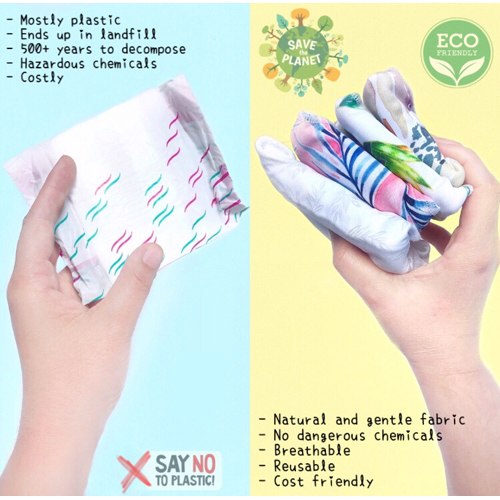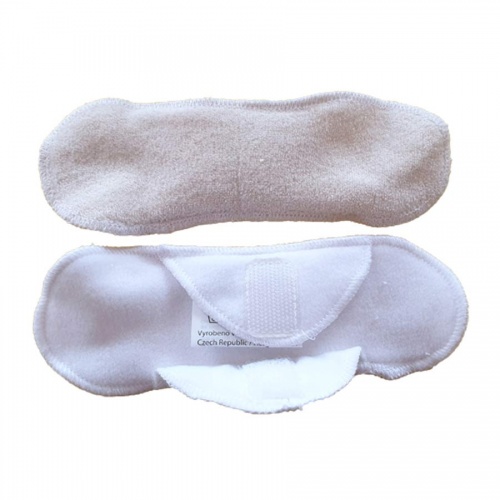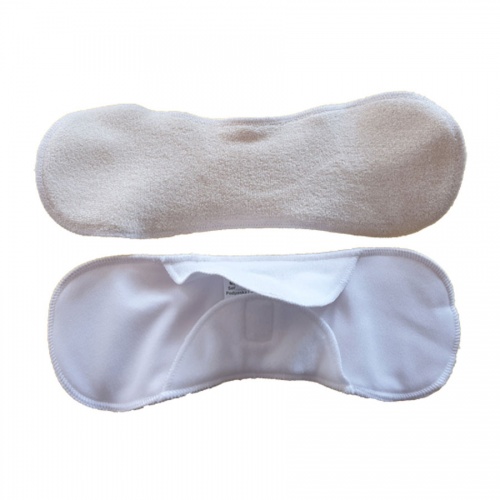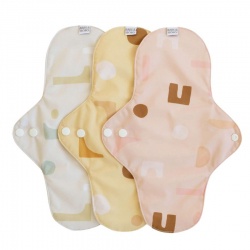Disposable V Cloth Menstrual Pads

Both types of sanitary pad do the same job to absorb menstrual blood however there are some key differences and pros and cons to each.
Cloth sanitary pads are washed and reused so no landfill waste is created. Disposable pads that go to landfill are estimated to take 500-800 years to break down due to the plastic content.* (1) If you’d like more information on plastic in menstrual products please read our separate article.
Cloth pads are cheaper long term than disposables. Cloth pads on general are expected to last 4-5 years however some of mine are older. How often they are used and washed plays a big part in their longevity. Panty liners used throughout the month are likely to wear out quicker than a heavy pad only used on day 1 of your period each month. Read our article "How Long Do Cloth Pads Last?" For more information.
Cloth pads usually secure with poppers underneath your pants gusset instead of adhesive backing. I hated the sound of taking a disposable pad off when I was a teenager in the school toilets, must admit I’m still not a fan now. It just sounds so loud and everybody knows your business. Then there is the annoying wing getting stuck to itself or the wrong place, annoying!! Cloth pads in comparison are almost silent. A popper or two to snap open/closed and you’re changed. There are a few pads on the market that come with Velcro instead of poppers, at the time of writing the only one we’re aware of and stock is the Bamboolik pads. Velcro pads are designed with cyclists and horseriders in mind where a popper stud could be a little uncomfortable if in the wrong place and under pressure. Velcro can also help those with dexterity or arthritis is in their hands. Disposables adhesive can also come unstuck if underwear gets wet whereas poppers/Velcro would hold fast. If you’re into those crazy muddy running fitness challenges, theme parks with ultra wet rides then this could be a problem for you.
Cloth pads are made of fabric. There are a number of different fabrics used in cloth pads such as cotton, bamboo or some manmade fabrics such as minky or fleece Each fabric has different properties and suits a different flow (see our separate article on the different types.)
Disposable pads can be made of a variety of materials depending on the brand. Always Ultra disposables which have synthetic layers, absorbing pearls, odour neutralising fragrances *(2)
A common reason for swapping to reusable cloth pads is to get away from unknown chemicals and fragrances. When pregnant with our third child I developed an allergy to disposable pads. 11 years on I still can’t use disposables as they make me itchy and sore.
Cloth pads are more breathable due to the nature of the materials they are made from. Even cloth pads with a waterproof PUL lining are breathable, PUL is NOT plastic. PUL allows air to flow while also providing waterproof protection. Breathable pads help keep your delicate area cool and comfortable. Natural materials will be more breathable than fleece or minky, as I’m so sensitive I stick to cotton, hemp or bamboo pads.
Cloth pads can be bulkier than disposables but not always. The size of your cloth pad depends on the type of pad (ie day or night), which fabric the pad is made of (bamboo is slimmer than minky), if there is a waterproof backing to prevent leaks. Our slimmest pads are the Bare/Boho range, Eco Femme, as these are all made of natural materials.
There is a wide variety of pads so you can choose one to match your exact needs. Pads all vary in size, width, length so you will be able to find one just right for you on every day of the month. If you need help on choosing the right quantity of pads read our article "How Many Pads Do I Need?" People are often worried about washing cloth pads but it's really simple. Use our guide "How to Wash & Care For Reusable Sanitary Pads."
1) Decomposition of disposable pads
2) Always Ultra Composition



.jpg)
